A rather amusing-looking little minstrelly ragtime band plays very nicely, then out comes fat Hazel Green to perform "Ain't She Sweet" altered to be about the band, "Ain't They Sweet."
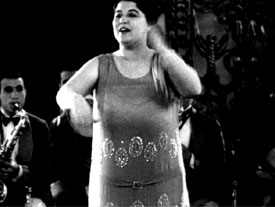 So begins the Vitaphone one-reeler Hazel Green & Company (1927). This isn't honestly her own "company" or orchestra however, but is the Vitaphone Orchestra conducted off-camera by Arthur Key. So begins the Vitaphone one-reeler Hazel Green & Company (1927). This isn't honestly her own "company" or orchestra however, but is the Vitaphone Orchestra conducted off-camera by Arthur Key.
The number is played at a speeded-up pace & Hazel's only moderately good, though there's definite charm in her. She soon leaps into a tune about a bird she thinks should "Fly away, fly away down south" & "Wish I were a little birdy too/ Just to get a bird's eye view/ Of a place I know of way down south."
In the 1920s many white jazz performers were billed as being of the unfortunate categorization "coon shouters" because they sang about the South, whether or not they'd ever lived there. This was a hold-over from Victorian minstrel shows & was attached to the "white ideal" of African Americans as childlike "darkies" who despite having fled north to places like New York, Washington, D.C., Chicago, St. Louis, & Kansas City, they really longed to be back on the plantation with a banjo (even if their fingers would be too bloodied by thorny cotton pods to play the damned thing).
The racist term may initially have applied to singers of "coon songs" in particular which had their heyday in the late 1900s but were recognized as offensive quite early in the new millenium. The term thereafter came to be applied to white ragtime soloists who belted out their songs loud enough for the last row; it was "race" music by style rather than by reference to "coons" but sentimentality about the South remained.
It eventually came to apply mainly to large women who sang about the South or in any style that borrowed from African American entertainers. These "coon shouters" tended to be white equivalents of Aunt Jemima, & fat singers like Hazel Green, May Irwin, & Sophie Tucker were the ideals. Even reubenesque Mae West started her career as a Coon Shouter, & Sophie Tucker was once forced to wear blackface very early in her career.
If anything good can be said of the designation, it at least acknowledged the cultural influences on white singers rather than misappropriating without credit, & it helped forge paths for authentic African American singers to reach wider, which is to say whiter audiences, & larger economic success as leading jazz entertainers. Coon shouters & ragtime stars are so intertwined in their origins that quite possibly jazz would not have arisen without this interlacing of the authentic & the caricatured & imitative.
I was amused to spot in an e-auction a photograph of Louis Beavers, a great character actress typecast by Hollywood as the motherly black maid, autographed to Hazel Green "the invincible personality." So Hazel was obviously a fan of Louise, seeking her autograph. And I like the idea of a feeling of comraderie going both ways between the character actress & the vaudeville singer, both being large women associated with the sounds of the south.
So Hazel Green was a typical coon shouter of the ragtime era, though fortunately by this time women weren't expected to get in blackface & tie a pokadot bandana around their head. Here she is singing her heart out about the South, & out comes a hick in bib overalls to tapdance very well as Hazel continues singing about way down south.
I wonder how far back the hillbilly tapdancer goes into vaudeville's take on minstrelsy. Was he a late comer when blackface began to be questionable, & "coon" began its slow fade from polite vocabulary? Or had there always been hillbillies in minstrelsy as parallels to "rustic darkies"?
Hazel shakes the frill of her flapper's tent of a dress while Joe Lacurta taps. This is apparently Joe's as well as Hazel's only film appearance, so neither were stars of screen, though we might assume they had reasonable Vaudeville careers whether separately or together.
Hazel "the invincible personality" conducts the orchestra which strikes up "That's Why I Love You," though she's only pretending to be the conductor. The banjo is a veritable lead instrument until the reeds take over. It's lively & sweet music, from a time before ragtime became stultified Disneyland music & was the advanced music of the age.
Hazel hasn't danced until now, but suddenly she busts into tapdance along with Joe who returned for his own second spot. It's all quite wonderfully done, & if minor Vaudeville personalities had all been this talented (which they were not) then Vaudeville might died more slowly.
Bryan Foy, formerly one of the child enterainers in Vaudeville's "Seven Little Foys," directed many Vitaphone Variety shorts which tended to be musically inclined with loads of comedy.
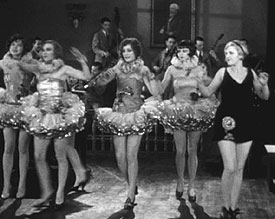 The comedy script for The Night Court (1927) was written by another early director, Murray Roth. Murray & Bryan together made a film with much more of a "story" than encountered in most of the earliest Vitaphone shorts that recorded acts without telling stories. The comedy script for The Night Court (1927) was written by another early director, Murray Roth. Murray & Bryan together made a film with much more of a "story" than encountered in most of the earliest Vitaphone shorts that recorded acts without telling stories.
At the Paradise Night Club, "Everything goes, including your pocketbook." We see men dancing with what appear to be chorus girls -- probably of the sort that were known as "taxi girls" who charged men for dances & were very closely associated with the sex trade.
Suddenly there's a police raid. The entire Revue from the Paradise Club is dragged into court & put on trial due to alleged lewdness in their show. Their attorney (William Dumarest) insists they be permitted to recreate their show for the judge, to prove that it was not all that lewd.
Dolly Lewis steps forth to deny the charge of singing risque songs. She then busts out into a flapper jazz number, "I Ain't That Kind of Baby," very nicely sung, with the jury box seating the a back-up band. The lyrics run in part:
"You can hold me on your knee/ But don't you try to gaga me/ I ain't that kind, I ain't that kind of a baby/ Let's go places, let's do things/ I'm not tied to apron strings/ Cuz I ain't that kind, I ain't that kind of a baby."
The chorus line was itself charged with "murder" -- of the dance called the black bottom. They collectively insist they're "Not guilty!" then do a chorus line dance to "The Black Bottom" played by the jury box band. The gals aren't great dancers but are very sweet & amusing traipsing & stomping about in their skimpy costumes.
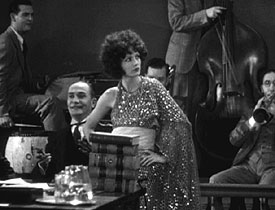 Some comedy shtick follows, between the judge & the defense attorney, then Irene Tobasco (Joyzelle Joyner) is charged with dancing in scanty attire. Some comedy shtick follows, between the judge & the defense attorney, then Irene Tobasco (Joyzelle Joyner) is charged with dancing in scanty attire.
She exclaims, like those before her, "Not guilty!" & goes into a vamp's slinky dance to an Arabic beat, very nicely done, & sexy. She has art deco grace & glamour, & she completely wins over the judge.
There's a lot of messing up in the film, as Vitaphone productions did not believe in wasting film, & retakes not at all likely to occur.
Lines are mispoken & even when the head of the judge's gavel falls off & bounces to the floor, there's no opportunity to fix it, & he thereafter pounds with just the handle.
Such flubs give it the feel of a live performance, not quite amateur because everyone very professionally presses on without being thrown by little mistakes & problems.
In the end the judge decides he has to see the act in context & wants a front table for the midnight revue. The court adjurns & everyone dances out of the courtroom while the jury box band reprises "The Black Bottom" with one guy playing two clarinets at once. The judge came down from his bench & personally leads the gals into town, with a couple final sight gags for good measure. Great stuff!
Two homely young ladies (Mary & Madeline Foy), accompanied by a hick with a ukelele (Richard Foy), sing "I Just Roll Along" which goes in part: "Goodbye, goodbye, goodbye blues/ I mix my joy & sorrow living as I do/ Goodbye, goodbye, goodbye blues/ I haven't got a thing to lose..."
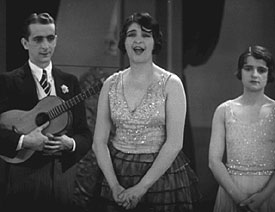 The sisters harmonize in a squally horrid way, & they've got some slightly amusing dance moves as unappealing as their frumpy dresses. The sisters harmonize in a squally horrid way, & they've got some slightly amusing dance moves as unappealing as their frumpy dresses.
When they're done murdering the song, three more Foys arrive, all guys. One (Rosco Foy) is wearing big silly buck teeth & equally silly clothes in the "baggy pants clown" tradition of Vaudeville. Rosco as comic relief seems unnecessary since the whole lot of Foys already look ridiculous enough without even trying to exaggerate themselves.
This act is apparently what former child-performers "The Seven Little Foys" grew up to be, renamed the Chips Off the Old Bloch (1928), the old bloch being father Eddie Foy functioning awkwardly as a sort of master of ceremonies.
The boys (including Charlie Foy, Irving Foy & Eddie Foy Jr) do a lot of very bad comedy shtick. Then Madeline tells a version of Little Red Riding Hood in which Red is butchered. Rosco dances like a rubber man, then Richard starts on the ukelele & the whole group sings "Bye Bye Pretty Baby" about how they're sad they have to leave now. Unfortunately the act isn't even over & they don't leave.
The entire load of Foys form a tap line & carry on to the bitter end, dancing to "Smile," the humor relying on the fac tthat they suck at dancing.
The unpromising because racist-sounding title The Happy Hottentots (1930) has nothing to do with the comedy that unfolds in this surprisingly effective wee film, which accurately reflects the tone, attitude, & emotions in the low end of show-business in those transition years when vaudeville began to give up ground to the motion pictures.
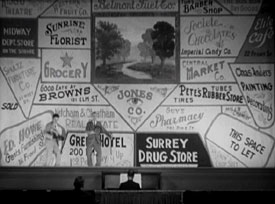 Joe Frisco in a bowler & a pal (Bob Callahan) in a straw hat come out of the White Rats Hotel onto the street. Joe's pal insists the two of them could do a great act. But Joe just as certain insists, "If my wife ever saw my name in front of a theater, she'd come back stage & kill me." Joe Frisco in a bowler & a pal (Bob Callahan) in a straw hat come out of the White Rats Hotel onto the street. Joe's pal insists the two of them could do a great act. But Joe just as certain insists, "If my wife ever saw my name in front of a theater, she'd come back stage & kill me."
His friend says, "We'll call ourselves the Reese Brothers, & nobody will know who we are." The story that unfolds is based on an actual incident in the career of a real comedy team, Duffy & Sweeney.
They get a booking in a cinema house where they do a fill-in act between feature films, under the thumb of a stage manager (Billy Gilbert) who scarcely has their well being in mind. But it almost seems like the film isn't playing, our comic singers are sent back on stage so rapidly throughout the evening.
They start off with a typical vaudeville number "Mandy Lane" while high-stepping spryly back & forth in front of a backdrop full of local advertising.
They're not great talents; if they were, they'd be in a real vaudeville venue rather than a cinema house. For their first performance, however, they manage at least some liveliness. When they come off the stage, they want to head off to their dressing room, but end up called back by the stage manager very, very quickly.
They run up & down the stairs to the dressing room without even time to change costumes, doing their act again & again, until there's no liveliness left in them.
A successful act was only expected to do two or three performances a day while in the lowest venues the poorer acts were expected to do their act eight times a day. "The Reese Brothers" find they're expected to do their act more than fifteen times, & long before the night is through, they're going through their paces like sleepwalkers who can barely stand.
The actors wring a lot of comedy out of the situation. It gets funnier & funnier as they get wearier & wearier, only partially in costume, & Joe decreasingly able to whistle or tapdance he's so worn out. They're not even given time to eat, & go on stage trying to sing "Mandy Lane" while eating sandwiches (which have moving carroway seeds in them).
Eventually they're barely able to walk back & forth in front of that backdrop of ads. There's only one sleepy-looking member of the audience in the house. Joe interrupts his slurred "Mandy Lane" in order to tell the last audience member, "Why don't you go home?" He replies, "I would, but I'm the janitor," so he's stuck there to the bitter end, then he'll sweep up.
At long, long last they are able to go to the hotel & collapse in a doublebed. Before dawn, there's a fire in the building, & they can't wake up. All the other residents are standing in their bedclothes in the street when they realize the Reese Brothers are still in the burning building.
There's a surprise ending too hysterical to reveal, you just gotta see it. It seems hardly possible it ever happened in real life, but as the story goes, it really did.
I'm kind of shocked Joe Frisco never became a big success in the cinema. In this little movie, he's about as funny as any comic actor of the time. His screen presence is really something. He was in fact a comedy headliner in vaudeville, but who knows why some of the finest vaudevillians just never made the transition to movie stardom as vaudeville was dying.
Continue to:
Still more "Vitaphone Varieties" among the extras
with the Jazz Singer 80th Anniversary Deluxe Edition
copyright © by Paghat the Ratgirl
|
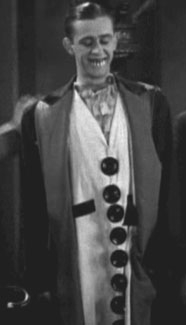
 So begins the Vitaphone one-reeler Hazel Green & Company (1927). This isn't honestly her own "company" or orchestra however, but is the Vitaphone Orchestra conducted off-camera by Arthur Key.
So begins the Vitaphone one-reeler Hazel Green & Company (1927). This isn't honestly her own "company" or orchestra however, but is the Vitaphone Orchestra conducted off-camera by Arthur Key. The comedy script for The Night Court (1927) was written by another early director, Murray Roth. Murray & Bryan together made a film with much more of a "story" than encountered in most of the earliest Vitaphone shorts that recorded acts without telling stories.
The comedy script for The Night Court (1927) was written by another early director, Murray Roth. Murray & Bryan together made a film with much more of a "story" than encountered in most of the earliest Vitaphone shorts that recorded acts without telling stories. Some comedy shtick follows, between the judge & the defense attorney, then Irene Tobasco (Joyzelle Joyner) is charged with dancing in scanty attire.
Some comedy shtick follows, between the judge & the defense attorney, then Irene Tobasco (Joyzelle Joyner) is charged with dancing in scanty attire. The sisters harmonize in a squally horrid way, & they've got some slightly amusing dance moves as unappealing as their frumpy dresses.
The sisters harmonize in a squally horrid way, & they've got some slightly amusing dance moves as unappealing as their frumpy dresses. Joe Frisco in a bowler & a pal (Bob Callahan) in a straw hat come out of the White Rats Hotel onto the street. Joe's pal insists the two of them could do a great act. But Joe just as certain insists, "If my wife ever saw my name in front of a theater, she'd come back stage & kill me."
Joe Frisco in a bowler & a pal (Bob Callahan) in a straw hat come out of the White Rats Hotel onto the street. Joe's pal insists the two of them could do a great act. But Joe just as certain insists, "If my wife ever saw my name in front of a theater, she'd come back stage & kill me."